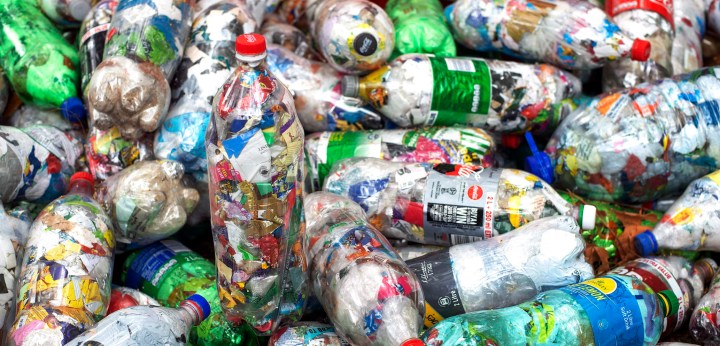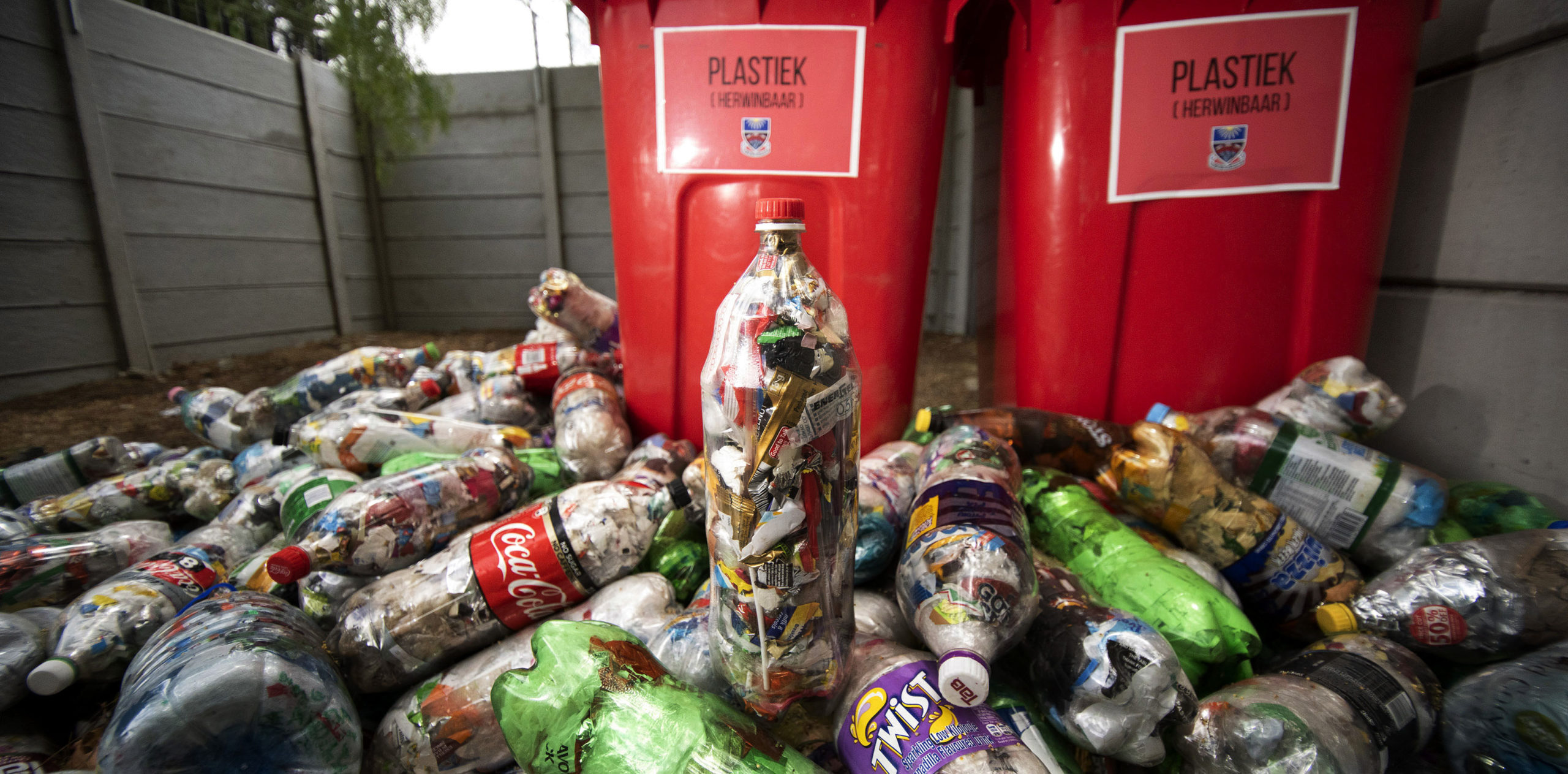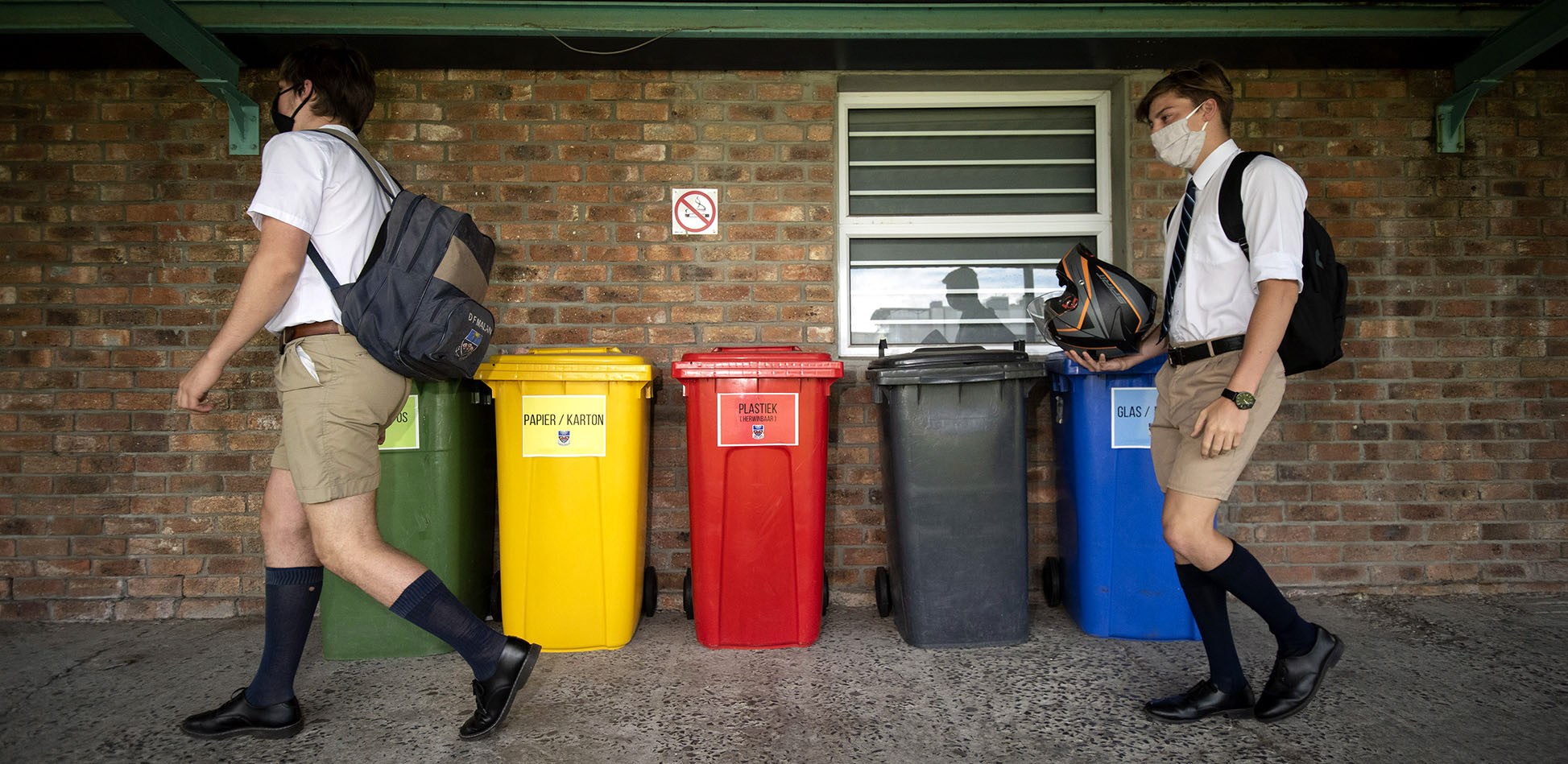MAVERICK CITIZEN
Not just another brick in the wall – ecobricks remain vital to conservation efforts

Despite a growing ecobrick pileup, waste management and conservation experts regard the recycling initiative as a vital stepping stone towards a non-recyclable-free existence.
It’s nearing the end of term in the pandemic year 2020 and no one at DF Malan High School is wearing a uniform, except the handful of masked matrics, heads down over last papers in the hall that has its doors thrown open for fresh air.
Behind the hall, beyond the administration buildings, four boys are making their way towards the school’s recycling depot on the other side of the vast sports fields. Two are pushing a trolley, really getting their backs into it to jemmy the heavily laden wheels over the ruts and bumps of the grass. One is pulling and steering the trolley. The last boy is carrying a box so laden with paper he has to hold it in place with his chin, his mask pulled down over his nose as his glasses fog up with the effort.
They’re on their way to the school’s waste sorting shed and Celeste Wepener, the teacher in charge of leading the school’s waste systems overhaul, stops to check in with them.
“Until we had a recycling competition last year, even the teachers didn’t really get the importance of recycling paper,” she said when the boys had continued on. “They mostly did it, because paper is the one thing we’ve always recycled, but it was rote. Now they put so much more thought into.”
It would be hard, in any case, to mindlessly throw away some paper at the school, because there aren’t many dustbins for general waste. In fewer months than needed to make up a full year — because Covid took a hearty chunk out of normal business — waste has been reduced to such a degree that instead of using the 40 bins supplied by the municipality, the school now uses only 25, saving the school around R2 500 a month. They intend to reduce the number of bins even further as they continue to practise new ways of thinking about the casual act of discarding.
The school did a waste audit at the end of 2018 and last year implemented a new order: organic waste into green bins, glass and metal into blue bins, paper into yellow bins, and recyclable plastics into red bins.
Classroom wastebaskets were removed and in their place were put two 2-litre plastic cooldrink bottles, harnessed together with unrecyclable packaging tape so that they would be stable. Every bit of non-recyclable waste — wax paper, chip bags, sweet wrappers, broken ballpoint pens — gets squashed down into these bottles until the waste is so compacted that the bottle doesn’t give when you stand on it.
These are called ecobricks, an approach to plastic waste management that’s been around for three decades but which is only just starting to catch on in the public imagination: plastic drink bottles stuffed with single-use plastics and other non-recyclable material are used as a robust, affordable, insulating building element.
It’s a simple idea that appears to offer answers to several questions. How do we build more homes? How do we create employment? How can we reduce the net area of the free-floating plastics that blight our world, degrading in an uncontrolled and harmful way to cause a list of environmental problems as long as your arm? How do we communicate how catastrophic our plastic-filled lives are — how full of death plastic is — to every single human on earth who uses shoes, shampoo, earbuds and toothbrushes, and who eats food bought from supermarkets?
Wepener takes me to the school’s recycling depot, a spot under an afdak near a gated entry wide enough for the trucks that come to collect the different materials in order to recycle them. It’s a neat and orderly place, considering it is a way station for what humans consider dross. On the other side of a vibracrete wall, two red wheelie bins parked under a pepper tree are floating in an island of ecobricks. Wepener guesses there to be about a hundred of them.
“These are a bit of a problem,” she says when asked who would be fetching them and where they were headed. “No one’s really taking them at the moment.”

Ecobricks, an imperfect but highly effective solution to reducing waste that can’t be recycled. (Photo: David Harrison)
In Lonehill in Joburg, Sean Williams has also found ecobricks recently to be “a bit of a problem”. He estimates that he has about a thousand ecobricks stacked in his garage.
“There used to be drop-off points all around Joburg, but they seem to have disappeared and because people know me from the ecobrick education work I’ve done, they bring them to me and I feel too bad to turn them away. I tell myself that at least the plastic is contained and not floating in the Jukskei, even if it is taking up space in my garage.”
Considering that Sean and a team of people he is paying R210 a day from funds he raised collected 7 000 bags — 52 000kg — of plastic out of the Joburg river and the streets of Four Ways in November 2020, one can understand his relief. The plastic is not gone. But neither is it flapping from hedges, fences and trees, or languishing in puddles of water. It has been trapped and, even if only temporarily, rendered harmless by being contained.
But there’s the problem with the ecobricks piling up. WhatsApp and Facebook neighbourhood and recycling or activist groups have desperate calls from individuals and companies saying “Where to with our good intentions?”
Ideally, “where to” would be towards building things: park benches, school gardens, stools, shelves — even houses, lapas and community centres, like the early childhood development centre in Delft in Cape Town, where internal walls were made of ecobricks.
“But it costs money,” says Williams. “I built a public bench using about 700 ecobricks. It’s about almost 2 metres long, and about a metre wide and it cost me R7 500. You have to pay for labour and materials. They don’t just build themselves.”
Candice Mostert, a waste management expert, educator and researcher, started Waste-ED six years ago after becoming interested in the potential of ecobricks. She has been involved in 25 sustainable building projects using ecobricks, which together diverted around 100,000kg of waste from landfills.
“Initially we were taking the ecobricks made by schools and organisations directly into planned builds, which is ideal because it was a great avenue for introducing people to sustainable building techniques. But then ecobricking really started taking off with private individuals. I kept getting calls from people wanting to deliver their bricks to us.”
Mostert worked out that, taking into account all aspects of a build using ecobricks and cob (a natural clay mixture), it costs around R50 per ecobrick to build a structure with a roof. Companies that do ecobricking as part of their social consciousness programmes are required to “back their brick” with some of the money required for building. Mostert, who at first accepted public bricks for free, decided to start the same thing for the public, where you pay R10 for each ecobrick you fill to make sure there is funding available for builds.
“The reaction has been about fifty-fifty, with some people being angry about it, and others who are supportive and happy to back their brick.”

Ecobrick collection bins at the DF Malan High School in Belville, Cape Town. (Photo: David Harrison)
Other organisations in the Cape have come and gone over the years, so that the public has often been left confused about what to do with their bricks. Waste-ED now has all its ecobrick pick-up points with zero-waste shops around the Peninsula.
“The idea is to connect people to the zero-waste idea as a full story.”
Williams worries that the ecobricks are not the final answer, but just a way of postponing the inevitable: dealing with plastic before we start choking in it like sea animals already are.
“The landfills in this country are almost full,” he says. “Then what?”
Other things worry him too: that people stuff recyclable materials into ecobricks, for instance, or the fact that the plastic of drink bottles is one of the most recyclable plastics around, plus they provide some income for waste pickers.
But while everyone involved in ecobricking understands that it is a temporary or partial solution, they all agree that the ecobrick is one of the most powerful education tools around.
Ecobricking is what is known as “plastic sequestering”. Unlike straightforward recycling, which allows domestic and commercial recyclers distance from the processes of turning their own daily plastic excesses of into something that can be used again in attempts to buy a few more years of relative planet health, ecobricking is hands-on. It can’t be outsourced. If an individual is worried about the amount of thin plastic film or cellophane coming into their home that they know will end up degrading in a landfill, they have to start shoving the wicked little scraps through a bottleneck with a stick themselves. It’s a tedious enough process to make anyone want to stop bringing home anything wrapped in plastic that should be available without the plastic.
Mostert says ecobricking is a way to monitor your own progress towards waste reduction.
“If a family produces two ecobricks a month, they eventually try and reduce it to one ecobrick, because they’re suddenly connecting the dots about where the plastic comes from and where it goes. So they start to shop more thoughtfully.”
The Global Ecobrick Alliance, on its website, says “It can be overwhelming to hear about the challenges of climate change, deforestation and glacial melting. Given this, the plastic pollution is unique … it is the only one we can touch. In fact, every day, we all handle plastic. Our daily usage of plastic enables small yet meaningful choices to reduce our participation in the petro-capital economy.”
Wepener says the most unexpected and heartening aspect of her school’s new waste systems has been the reports she’s been getting from scholars about how their families have started to think differently about plastic in the home since the school’s recycling systems have been overhauled.
“Our system is far from perfect or complete,” she says, “but it’s better for everyone to try and do something small, than for one person to try and do something perfectly.”
Or for no one to do anything. DM/MC






















 Become an Insider
Become an Insider
The green and brown 2 litre bottles are best as the recyclers often leave those behind. If you are lucky there will be a special skip for those, as there is at our local Pikitup depot. There is a use for those- they are turned into pale green roof insulation.
I live in Stellenbosch and have a similar problem – I have stuffed about ten bricks and don’t know what to do with them. Any suggestions welcome.